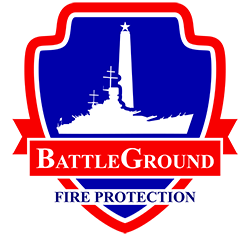

Since 1864, Fire sprinkler systems have been the first line of defense when protecting lives and property in many types of buildings and applications spanning a wide spectrum of industries. Many building codes at the federal, state and municipal levels require the use of sprinkler systems in certain occupancies. There are several types of Automatic Sprinkler Systems that could be uniquely suited to your building, its occupants and applications within the facility. BattleGround Fire Protection will help you determine the best solution for protecting lives and property while working with you to design the best system to fit your needs. We offer services that include the entire cycle of fire suppression systems such as consultation, design, installation, maintenance, inspection and repair services.
BattleGround's fire sprinkler system inspection and preventative maintenance services, will allow you to feel confident that your systems are prepared to protect the lives of the building’s occupants, protect your property, as well as pass your local fire protection jurisdiction requirements. Inspection and maintenance of sprinklers are required on a monthly, quarterly, semiannual, annual, and five-year basis. We can work with you to design an inspection and maintenance program that will keep you up to date and safe. By performing the required inspection and maintenance to your systems, you will help extend the life of the system, improve its reliability and reduce the overall cost of maintenance.
At BattleGround our design staff utilizes 3D CAD design programs which enable us to coordinate fire sprinkler design with other trades involved with any of our projects. We can design systems for a wide variety of facilities including data centers, warehouses, retail spaces, residential or any other site where a wet or dry system is required or pre-exsisting. Our experienced technicians can handle fire protection-related emergencies of any kind and size.
Fire Hydrant Flow Test
We calculate the flow rate (GPM) and pressure (PSI) at a specific point in the water supply.